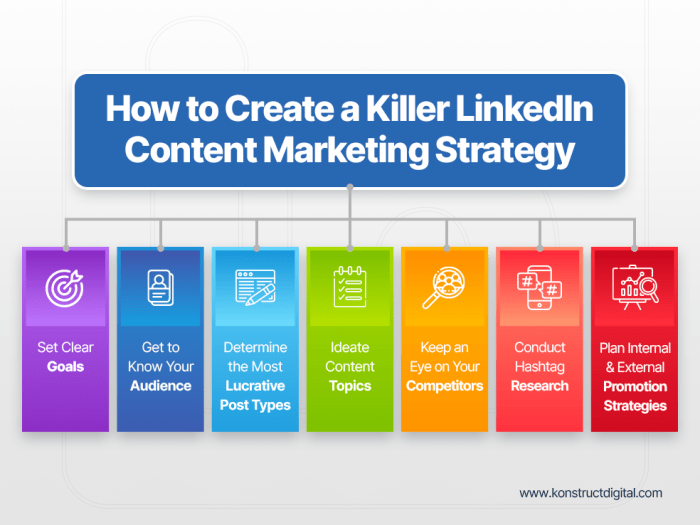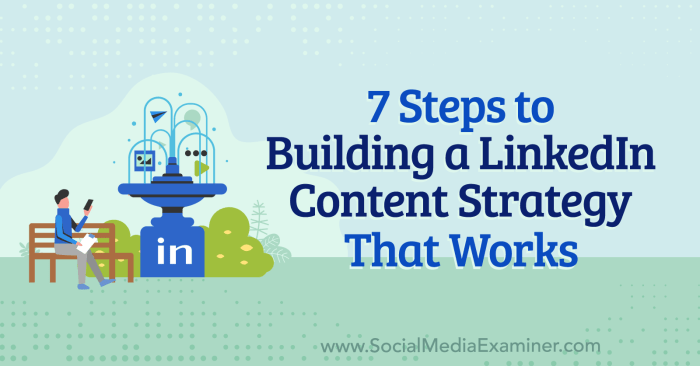Creating a LinkedIn Content Strategy is key to thriving on the platform, and this guide will show you how to do it effectively. From setting goals to engaging with the community, we’ve got you covered.
Understanding LinkedIn Content Strategy
A content strategy on LinkedIn refers to the plan and approach a user or business takes to create and share content on the platform. It involves setting goals, identifying target audiences, creating relevant content, and determining the best ways to distribute and promote that content.
Having a content strategy on LinkedIn is crucial for success because it helps users or businesses to establish a consistent online presence, build credibility and authority in their industry, engage with their target audience, and ultimately drive desired actions such as generating leads or conversions.
Examples of Successful LinkedIn Content Strategies
- 1. HubSpot: HubSpot utilizes LinkedIn to share informative and educational content related to marketing, sales, and customer service. They focus on providing value to their audience through blog posts, videos, and infographics, positioning themselves as thought leaders in the industry.
- 2. Gary Vaynerchuk: Gary Vaynerchuk, a popular entrepreneur and influencer, leverages LinkedIn to share motivational and inspirational content. He uses personal stories, quotes, and videos to connect with his followers and inspire them to take action in their own lives or businesses.
- 3. Microsoft: Microsoft uses LinkedIn to showcase their company culture, employee stories, and industry insights. They humanize their brand by highlighting the people behind the technology, which resonates with their audience and strengthens their employer brand.
Setting Goals and Objectives
Setting clear goals for a LinkedIn content strategy is crucial for its success. These goals help establish a roadmap for what you want to achieve with your content and how you plan to measure success. Aligning these goals with the overall business objectives ensures that your content efforts are contributing directly to the growth and success of the business.
Defining Clear Goals
To define clear goals for a LinkedIn content strategy, start by identifying what you want to accomplish. This could be increasing brand awareness, generating leads, driving website traffic, or establishing thought leadership. Make sure these goals are specific, measurable, achievable, relevant, and time-bound (SMART). For example, a goal could be to increase engagement on LinkedIn posts by 20% within the next quarter.
Aligning with Business Objectives
It’s essential to align your content strategy goals with the overall business objectives to ensure that your efforts are contributing to the bottom line. For instance, if the business objective is to increase sales by 10% this year, your content goals could focus on generating leads and conversions through LinkedIn content.
Examples of Specific Goals
– Increase LinkedIn followers by 25% in the next six months.
– Generate 100 new leads from LinkedIn content within the next quarter.
– Increase website referral traffic from LinkedIn by 30% in the next year.
Identifying Target Audience
Identifying the target audience is crucial when creating a LinkedIn content strategy as it helps in crafting content that resonates with the right people, drives engagement, and ultimately achieves desired outcomes.
Significance of Knowing the Target Audience
Knowing the target audience on LinkedIn allows you to tailor your content to meet the specific needs, interests, and preferences of your ideal audience. It helps in creating relevant and valuable content that speaks directly to the people you want to reach, increasing the chances of building meaningful connections and driving conversions.
- Conducting market research to understand the demographics, interests, behaviors, and pain points of your target audience.
- Utilizing LinkedIn Analytics to gather insights on the demographics, engagement metrics, and preferences of your followers.
- Engaging with your audience through polls, surveys, and direct messages to gather feedback and understand their needs.
Techniques for Identifying the Target Audience on LinkedIn
Identifying and understanding the target audience on LinkedIn can be achieved through various techniques such as:
- Creating buyer personas based on demographic data, job titles, industries, and interests.
- Utilizing LinkedIn’s audience targeting features to reach specific segments based on criteria like location, industry, company size, and job function.
- Monitoring engagement metrics to identify trends, preferences, and content performance among different audience segments.
Tailoring Content Strategies for Various Target Audience Segments
Different target audience segments require tailored content strategies to effectively engage and connect with them. Examples of how content strategies can be customized include:
| Target Audience Segment | Content Strategy |
|---|---|
| Marketing Professionals | Focus on thought leadership content, industry trends, and case studies to showcase expertise. |
| Small Business Owners | Provide practical tips, success stories, and resources to help them grow their businesses. |
| Recent Graduates | Share career advice, job search tips, and personal development insights to support their professional journey. |
Content Creation and Curation
Creating and curating content on LinkedIn is crucial for building a strong presence on the platform. It helps you engage with your audience, establish thought leadership, and drive meaningful conversations. Let’s dive into the types of content that perform well, tips for creating engaging posts, and the importance of balancing created and curated content.
Types of Content on LinkedIn
- Original Articles: Sharing in-depth insights and expertise on relevant topics can position you as a thought leader in your industry.
- Visual Content: Images, videos, and infographics tend to grab attention and increase engagement.
- Company Updates: Sharing news, milestones, and behind-the-scenes content humanizes your brand and builds trust with your audience.
- Industry News: Curating and sharing relevant industry news and trends shows that you stay informed and adds value to your network.
Tips for Engaging Content, Creating a LinkedIn Content Strategy
- Know Your Audience: Tailor your content to resonate with your target audience’s interests, challenges, and preferences.
- Use Compelling Headlines: Capture attention with catchy headlines that entice users to click and read your post.
- Add Value: Provide actionable insights, tips, and solutions that benefit your audience and make them want to share your content.
- Include Visuals: Incorporate eye-catching visuals to break up text and make your posts visually appealing.
Balance Between Created and Curated Content
While creating original content showcases your expertise and unique perspective, curating content from reputable sources helps you stay relevant and provide diverse insights to your audience. Finding the right balance between the two ensures your LinkedIn feed remains engaging, informative, and valuable.
Content Distribution and Promotion
To maximize the impact of your LinkedIn content, it’s crucial to effectively distribute and promote it to reach a wider audience. By utilizing various strategies and features on the platform, you can increase visibility and engagement with your posts.
Distributing Content Effectively
- Regularly share content on your LinkedIn feed to keep your audience engaged and informed.
- Utilize LinkedIn Groups to share your content with specific communities that align with your target audience.
- Consider leveraging LinkedIn Ads to boost the visibility of your content to a larger audience.
- Collaborate with influencers or industry experts to share your content with their followers, expanding your reach.
Promoting Content for Wider Reach
- Engage with your audience by responding to comments and messages on your posts to foster a sense of community.
- Share your LinkedIn content across other social media platforms to drive traffic back to your profile.
- Participate in LinkedIn engagement pods or groups to increase visibility and engagement with your posts.
- Utilize hashtags strategically to make your content more discoverable to users searching for specific topics.
Utilizing LinkedIn Pulse for Content Distribution
LinkedIn Pulse is a powerful feature that allows you to publish long-form content directly on the platform, reaching a larger audience beyond your connections. By utilizing LinkedIn Pulse, you can establish yourself as a thought leader in your industry and attract a wider audience to your profile. Make sure to optimize your Pulse posts with relevant s, engaging visuals, and compelling headlines to increase visibility and engagement.
Analyzing and Measuring Performance

To effectively evaluate the success of a LinkedIn content strategy, it is crucial to track key metrics that provide insights into the performance of your content. By analyzing these metrics, you can make informed decisions to optimize your strategy for better results.
Key Metrics to Track
- Engagement Rate: Measure the level of interaction your content receives from your audience, including likes, comments, and shares.
- Click-Through Rate (CTR): Evaluate the percentage of users who clicked on a link included in your content, indicating interest and engagement.
- Follower Growth: Monitor the increase in your follower count over time to assess the impact of your content on audience growth.
- Impressions and Reach: Track the number of times your content is displayed (impressions) and the unique users who see it (reach) to gauge visibility.
Using LinkedIn Analytics
LinkedIn provides a robust analytics tool that allows you to measure the performance of your content effectively. By accessing these insights, you can gain a deeper understanding of how your audience interacts with your posts and make data-driven decisions to enhance your strategy.
Utilize LinkedIn analytics to track metrics such as engagement, reach, and follower demographics to refine your content strategy.
Best Practices for Interpreting Data
- Regularly Review Metrics: Monitor key performance indicators (KPIs) consistently to identify trends and patterns in your content’s performance.
- Compare Results: Compare the performance of different types of content to determine what resonates best with your audience and adjust your strategy accordingly.
- Experiment and Iterate: Test new approaches and content formats based on insights from analytics, and continuously refine your strategy for optimal results.
Engaging with the LinkedIn Community: Creating A LinkedIn Content Strategy

Engaging with the LinkedIn community is crucial for building relationships, establishing credibility, and expanding your network. By actively participating in conversations, sharing valuable insights, and connecting with like-minded professionals, you can enhance your visibility and attract potential opportunities.
Strategies for Community Engagement
- Regularly engage with posts in your feed by commenting thoughtfully and providing valuable input.
- Share relevant content from others in your network to show support and foster collaboration.
- Send personalized messages to connections to initiate conversations and build rapport.
- Participate in LinkedIn groups related to your industry or interests to connect with like-minded professionals.
Importance of Building Relationships
Building relationships on LinkedIn is essential for establishing trust, credibility, and long-lasting connections. By engaging authentically with others, you can create meaningful interactions that lead to potential collaborations, partnerships, or job opportunities.
Examples of Successful Engagement Strategies
- Responding promptly to comments on your posts to encourage further discussion and interaction.
- Engaging with influencers in your industry by sharing their content and adding valuable insights.
- Participating in LinkedIn Live sessions to interact with your audience in real-time and showcase your expertise.
